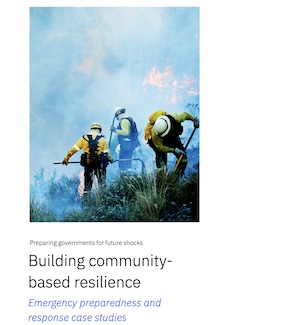
Building community- based resilience

Governments, public sector leaders, and their communities face an increasing number of high-impact events. Severe storms, wildfires, flooding, power outages, and large-scale infrastructure disruptions are growing problems that test the readiness of institutions and the adaptability of communities.
The lessons of recent years make one reality clear: the ability to anticipate and prepare for disruptions before they occur is just as critical as the capacity to respond and recover afterward. This report offers new perspectives from real-world examples of how distributed capacity, integrated networks, and forward-thinking planning can transform preparedness and response to benefit communities everywhere.
The four case studies in this report highlight innovative approaches that position decision-making, resources, and information closer to the front lines:
- California’s Community Brigades demonstrate how training and equipping neighborhood-based teams can extend official firefighting capacity and strengthen public trust in emergency operations.
- Florida’s Department of Transportation (DOT) Resilience Action Plan uses statewide scenario planning tools and standardized data to help local agencies anticipate and mitigate infrastructure risks before they escalate.
- Texas’s BeforeDuringAfter.com consolidates more than 10,000 local resources into a single platform to give small businesses and local governments clear, actionable guidance in the face of disruption.
- Great Britain’s Emergency Services Network integrates secure, resilient communications across police, fire, ambulance, and other responders, helping to ensure coordination when it matters most.
These examples demonstrate that resilience is not a passive trait but a deliberate strategy. By proactively embedding capability at multiple levels, investing in accessible information systems, and formalizing cross-sector partnerships, governments can have a greater likelihood of effectively managing uncertainty and addressing future events.
In addition to these inspiring and innovative case studies, the report concludes with an action guide with four imperatives and self-check questions that leaders can use to assess their own readiness to act. These actions are designed to be practical, thought-provoking, and adaptable to different contexts, providing a clear path to building a safer, more prepared future.



